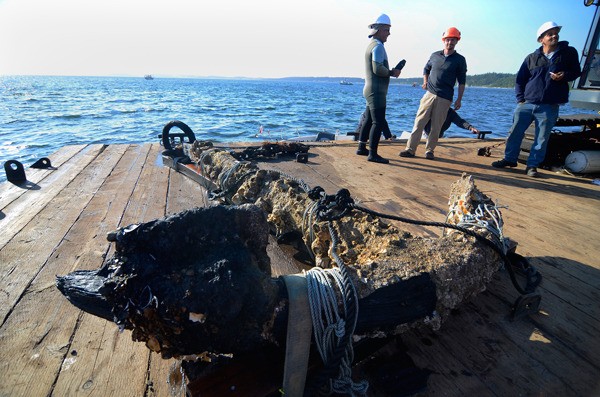First they cheered, then they wept.
The long-submerged anchor believed connected with Captain George Vancouver and his famed exploration of the Pacific Northwest more than 200 years ago touched down on the deck of a barge off Ledgewood late Monday. It was a moment of joy, but also one of closure, as it marked the end of six years of research, toil and obsession.
 “I’m pretty overcome right now,” said a teary-eyed Scott Grimm, moments after the anchor was recovered. “It’s been a long time.”
“I’m pretty overcome right now,” said a teary-eyed Scott Grimm, moments after the anchor was recovered. “It’s been a long time.”
The anchor was discovered in 40 feet of water by Doug Monk, a diver and ship captain, in 2008. Teaming up with Grimm, they have spent the years since trying to identify the relic, jumping through the hoops of establishing legal ownership and navigating the state’s lengthy permit process.
They contend it’s the stream anchor lost on June 9, 1792, from the HMS Chatham, the 80-foot survey brig that accompanied Vancouver and the HMS Discovery on the famed exploration of Puget Sound.
Recovering the relic, exactly 222 years after the Chatham’s anchor was lost, was no easy task. Small teams of divers spent most of the day working in tough conditions.
“Howling,” said diver Laura James, describing the swift current. “Probably the strongest current I’ve ever worked in.”
The team attached a cradle to the old anchor, estimated to weigh more than 1,000 pounds, that would support the artifact as it was lifted to the surface. Puget Sound doesn’t release her treasures so easily, however, and recovering the anchor without breaking it was tricky due to one fluke that was stuck fast to the seafloor.
Divers tried first to dig out around the fluke, then used airbags, but it wouldn’t budge. In the end, it was painstakingly pulled free with a crane that pulled from an angle that would free it without damage.
“I’m just happy we didn’t break it,” said Monk, a man of rough hands and Carhartt coveralls. “It made it worth the extra trouble.”
He said he was “ecstatic” to get the anchor up in one piece, but that Monday’s successful raising was a relief in more ways than one. While there are many more chapters yet to be written about this anchor, Monk is ready for this adventure to come to an end.
“I’d say I’m about done,” he laughed.
And that was music to his wife’s ears. Li Li has been the consummate supporter, but she is looking forward to talking about something else for a change.
“It’s been a long project … most of our conversations end with the anchor,” said Li, with a smile.
 For many others, however, the mystery of the anchor is just getting started. Where it will end up after it’s restored, possible squabbles over ownership, and of course from what vessel this anchor was lost are all future topics of discussion.
For many others, however, the mystery of the anchor is just getting started. Where it will end up after it’s restored, possible squabbles over ownership, and of course from what vessel this anchor was lost are all future topics of discussion.
The authenticity of the anchor’s origins, which flies in the face of conventional belief that it was lost near Bellingham, has sparked debate and will likely continue to do so. Indeed, before the boats of Monday’s recovery had returned to port, experts on board were already speculating. A few expressed certainty that it is the Chatham’s anchor, others quiet doubt and some offered guarded opinions.
“It’s an anchor; that’s my expert opinion,” said Scott Williams, an archeologist who specializes in marine recovery.
On board largely as an observer, Williams was also charged with ensuring conditions of the recovery permit were followed, such as making sure the anchor was kept wet until it reached a special tank built for the relic at the Northwest Maritime Center in Port Townsend. It will spend the next few weeks there before being trucked to Texas A&M University for restoration. That process may reveal definitive answers, but it may not.
“It’s hard to prove much in archaeology,” Williams said.
The team could get “lucky” and find an embossment of the British navy on the anchor, but it’s considered a long shot. Like the wheel of a car, there will likely be little to definitely tie the artifact to the Chatham.
“A lot of it is going to come down to Scott’s [Grimm] research,” Williams said.
But even if it’s not what some hope, it’s still a very old anchor and it has a story to tell, said Bob Mester, a marine recovery expert and owner of Underwater Admiralty Sciences.
“It’s a wonderful find and nothing should detract from that,” Mester said.
The search for the Chatham’s anchor has captured the imagination of historians for years, including Mester, and news that this could be the same object has sparked countless discussions over its authenticity. That alone is valuable, Mester said.
As for Grimm, he says there is probably no way to know for sure, with absolute certainty, that this is the Chatham’s anchor. However, he believes his research, some of which he has yet to reveal, will make a case too compelling to challenge.
“It’s a great feeling,” said Grimm, gazing at the barnacle-encrusted anchor. “I think we’re going to be vindicated.”


